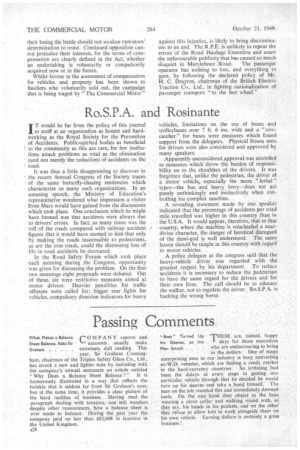Ro.S.P.A. and Rosinante
Page 30

If you've noticed an error in this article please click here to report it so we can fix it.
IT would be far from the policy of this journal to scoff at an organization as honest and hardworking as the Royal Society for the Prevention of Accidents. Public-spirited bodies as beneficial to the community as this are rare, for few institutions attack problems as vital as the elimination (and not merely the reduction) of accidents on the road.
It was thus a little disappointing to discover in the recent Annual Congress of the Society traces of the same butterfly-chasing tendencies which characterize so many such organizations. In an amusing speech, the ' Ministry of Education's representative wondered what impression a visitor from Mars would have gained from the discussions which took place. One conclusion which he might have formed was that accidents were always due to drivers' errors. In fact, so many times was the toll of the roads compared with railway accident figures that it would have seemed to him that only by making the roads inaccessible to pedestrians, as are the iron roads, could the distressing loss of life in road accidents be decreased.
In the Road Safety Forum which took place each morning during the Congress, opportunity was given for discussing the problem. On the first two mornings eight proposals were debated. Out of these, six were restrictive measures aimed at motor drivers. Heavier penalities for traffic offences were called for; bigger rear lights for vehicles, compulsory direction indicators for heavy vehicles, limitations on the use of buses and trolleyb uses over 7 ft. 6 ins, wide and a "cowcatcher" for buses were measures which found support from the delegates. Physical fitness tests for drivers were also considered and approved by many speakers.
Apparently unconsidered approval was accorded to measures which throw the burden of respOnsibility on to the shoulders of the drivers. It was forgotten that, unlike the pedestrian, the driver of a motor vehicle, especially the more " lethal" . types—the bus and heavy_ lorry—does not act purely unthinkingly and instinctively when con trolling his complex machine. '
A revealing statement made by one speaker indicated that the percentage of accidents per road mile travelled was higher in this country than in the U.S.A. It would appear, therefore, that in that / country, where the machine is vouchsafed a neardivine character, the danger of heretical disregard of the demi-god is well understood. The same lesson should be taught in this country with regard to motor vehicles.
A police delegate at the congress said that the heavy-vehicle driver was regarded with the greatest respect by his department. To reduce accidents it is necessary to induce the pedestrian to have the same regard Or the drivers and for their own lives. The call should be to educate the walker, not to regulate the driver. Ro.S.P.A. is backing the wrong horse.




























































































